Migratory Pollinators Program
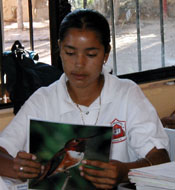  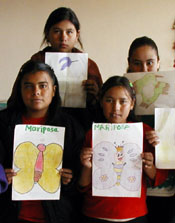 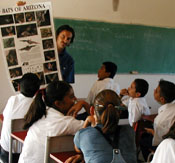 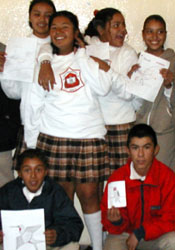 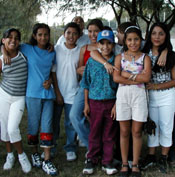 |
Education in Schools
Presentations including talks, hands on activities, and field trips were given at many schools in southern Arizona and western Mexico including Jalisco, Sinaloa, and Sonora. The Education Outreach Program also conducted training workshops for teachers throughout Sonora and Arizona.
- In Tucson, the pollinator education materials were pilot-tested
on numerous schools, and included in teacher education programs. Presentations
were also made at schools in Sierra Vista, Arizona.
- ASDM has
provided schools on the Tohono O'odham Indian Reservation (an important area for
bats and doves) with desert environmental education programs including materials
on pollinators.
- Talks were given in Hermosillo to secondary school
level students at the Centro Ecológico.
- ASDM conducted teacher training workshops reaching approximately 139 teachers in 96 schools. This course covered pollination biology, migratory routes, pollinator importance/value, threats and conservation, and identification of pollinators and key floral resources.
- ASDM staff made presentations on the climate and natural history
of the Sonoran Desert, pollination biology, migration, hummingbirds, and bats
that reached more than 2,000 students in Sonora. Hummingbird feeders and
sugar were distributed to all schools where presentations were made. Teachers
collected plant and hummingbird data for the Migratory Pollinator Project. Students
drew hummingbirds, white-winged doves, butterflies, or bats. On the back of the
cards they wrote Christmas messages, something about the animal that they drew,
and their names and the schools. The cards were exchanged with students in other
participating schools.
- Biologists from ASDM and the Universidad
de Sonora and educators from CEDO in Puerto Peñasco and the Centro Ecológico de
Sonora in Hermosillo gave presentations at a workshop in San Ignacio, Sonora attended
by 32 teachers. In addition to the presentations, there were various activities
including bird watching, hummingbird banding, listening to bat echoes at night,
observing insects at night, and star-gazing. Each teacher received a set of materials
related to the natural history and conservation of the Sonoran Desert including
books, computer materials, brochures, and seed packets for wildflower gardens.
Teachers evaluated the program and were given an official diploma from the Secretaría
de Educación y Cultura in Hermosillo that awards points toward their salaries
for their participation in this training course.
- ASDM, Centro
Intercultural para de Estudios de Desíertos y Océanos (CEDO), and Bat Conservation
International (BCI) conducted a workshop entitled "Migratory Pollinators in the
Sonoran Desert," a 22 hour certification based teacher training session at CEDO
(Puerto Peñasco). The workshop included a field trip to the Pinacate Biosphere
Reserve (35 teachers from Sonoyta, Caborca, and Puerto Peñasco, and 5 staff from
the Pinacate Biosphere Reserve attended). The program funded follow-up field
trips for teachers and their students to experience the natural area first hand
and observe pollinators in their habitats.
- Pronatura Sonora, one
of our partners in this project, coordinated educational programs in schools in
Guaymas and Empalme. Traveling pollinator "trunks" containing pollinator
information, activities, and stories, were developed and distributed to 52 schools
reaching more than 2,500 students through a team of 16 trained teachers.
Pollination wisdom, migration challenges, habitat and conservation, and people,
nature, and culture were the focus of the education program.
- Another
partner, Instituto del Medio Ambiente y el Desarrollo Sustentable del Estado de
Sonora (IMADES), developed different education outreach approaches in the town
of Alamos, Sonora. This town is popular with eco-tourists and attracts
Leptonycteris bats and hummingbirds. Talks were given to students
in schools and at conferences at Centro Ecológico.
- In Jalisco State, ASDM and the Programa de Conservación de Murciélagos Migratorios (PCMM) jointly focused their education programs in communities near where Leptonycteris bat roosts are located, and in communities near agave plantations (important floral resource for bats and hummingbirds). Communities included Amatitán-Tequila, Ajijic, Techaluta de Montenegro and Guadalajara.
Community Education
Education
materials were distributed and presentations were made to community members at
a variety of community centers including libraries, museums, civic centers, restaurants,
Bed & Breakfasts, ranches, clubs, etc. Local residents and business
owners were encouraged to pass out materials to tourists and other residents as
well as collect data for the Migratory Pollinators Program.
- In Punta
Chueca and Desemboque, Seri Indians through the ASDM para-ecologist training program,
received instruction in mist-netting techniques for bats and hummingbirds and
how to identify which type of bat is occupying particular roost caves.
- Packages with brochures, pollinator educational materials, and field
data collection forms were sent to hotels, non-governmental organizations, individuals,
and government organizations in Sonora, Chihuahua, and Sinaloa, Mexico.
These groups/businesses have become "Partners in Pollination" passing out pollination
brochures and information as well as providing the Migratory Pollinator Program
with pollinator data from their sites.
- Migratory Pollinator Program
workshops were conducted for the Arizona Bed & Breakfast Association with
emphasis on data collection ("Partners in Pollination") and the use of native
plants in gardens.
- Pronatura Sonora organized a pollination mass
media campaign including spots on radio, television and in state and local newspapers.
- IMADES gave community pollination talks in Alamos in a local museum, at the Delegation of Tourism, at the local Cattle Raisers Association meeting, and at several non profit offices, and at the Municipal Office. They passed out brochures and information as well as recruited many of these groups to pass out more flyers. They prepared radio talks and gave a talk during the National Week of Science and Technology in Hermosillo.
-
ASDM and PCMM gave community presentations in Jalisco State and met with the Tequila Industry Chamber of Commerce and locals associated with a Tequila Museum and an ecotourist train, the Tequila Express, to encourage bat/agave education and conservation.
-
A bilingual poster and educational project for small farmers teaching the advantages of wild habitat around farms to attract pollinators is in preparation by The Bee Works and ASDM.
Pollinator
Gardens
Encouragement of nectar-rich resource oases has been an emphasis of the
Outreach Program. The Migratory Pollinator Program promotes the establishment
of pollinator gardens as habitats that can provide shelter, food, and water for
migratory species. These gardens are used as observation sites for research
and provide an opportunity to educate local communities and encourage participation
in conservation efforts.
-
Emphasized pollinator gardens in Migratory Pollinator workshops for Arizona Bed & Breakfast Association to motivate them to plant native plants.
-
Provided technical and material support to establish a pollinator garden at San Xavier Community Center (Tohono O'odham Nation).
-
Provided technical and material support to establish pollinator gardens at 6 schools/sites in Arizona and Sonora, Mexico.
-
Provided technical support to the Sonoran Institute to establish a pollinator garden in a Santa Cruz River community in Sonora, Mexico.
-
A Desert Pollinator Garden Kit is in preparation. This kit provides resources and instructions for K-5 teachers to help them design and implement a schoolyard pollinator garden with their students. The package includes:
36 pollinator plant cards with illustrations of desert plants in bloom and detailed descriptions of plant care, natural habitat, uses, and pollinator associations
-
Step by step instructions for designing, planting, and caring for a desert pollinator garden
-
K-5 activities for designing the pollinator garden and using it as an outdoor classroom
-
Additional resources for teachers
-
Book on schoolyard habitat design for the arid southwest.
Pollinator Garden Website (in preparation).
Workshops and Conferences Attended by Outreach Staff
-
North American Association for Environmental Education (NAAEE) conference, South Padre Island, TX 2000.
National Association for Interpretation (NAI) Conference, Tucson, AZ 2000.
Yuma Birding and Nature Festival, Yuma, AZ 2001.
Ironwood Festival, Tucson, AZ 2001, 2002.
Southwest Wings Festival, Sierra Vista, AZ 2000, 2001.
Arizona Bat Conservation and Management Workshop, Portal, AZ 2001.
Hummingbird Banding Conference, Silver City, NM 2001.
CONCLUSIONS
The
Education and Community Outreach portion of this program has been an outstanding
success. We were overwhelmed with the positive responses from students,
teachers, local landowners, businesses, and civic groups. Interest in pollinator
issues and a desire to participate in research and conservation efforts exists
across the entire migratory pollinator region. Teachers traveled great distances
to attend the workshops and frequently parents came to school with their children
to hear the presentations. Businesses, landowners, and civic groups were
eager to offer their knowledge of local natural history and to hang hummingbird
feeders, plant pollinator gardens, and pass out literature.
Our education efforts have served to focus attention on the importance of pollinators and the role of local people in the preservation of pollinator habitats. We have been able to provide information and assistance in the creation of community-based data gathering and monitoring. We plan to continue supporting community efforts to develop sustainable practices along migratory corridors and to reinforcing the importance of community action in conservation.
Top of Page | Previous Page | Next Page